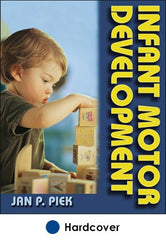Piaget's cognitive schemas describe the development of cognition
This is an excerpt from Infant Motor Development by Jan Piek.
Jean Piaget has often been described as the most influential developmental psychologist to date. He highlighted the importance of reflexes in early development (Piaget, 1953), not only in relation to motor development, but also in relation to cognitive development. According to Piaget, knowledge is acquired through action, either physical or mental. He described the development of cognition as a progression through four distinct stages, with each involving quite discrete processes. It is the first of these stages, the sensorimotor stage occurring from birth to two years of age, that is particularly relevant to understanding early infant development.
Throughout the sensorimotor stage, physical action is the primary source of new information. Piaget argued that infants are not born with any reasoning or representational capacity, but that these cognitive abilities emerge as a result of sensorimotor experiences. He placed considerable importance on these early movements as he argued that newborn infants must actively explore their environment in order to interpret their world and self.
Piaget's sensorimotor stage of cognitive development consists of six different substages as outlined in table 2.2. These substages were derived primarily from observations of his own children, Jacqueline, Lucianne, and Laurent (Piaget & Inhelder, 1969).
In the first few months (substages I and II), the young infant acquires knowledge through schemas, with schema defined as “a concept or framework that organizes and interprets information” (Myers, 2001, p. 127). Schemas are the way in which each individual acts on the environment, and can be biological or mental in nature. Schemas available to a young infant are biological and very limited, and they initially consist primarily of reflexes. For example, one schema that allows the infant to acquire knowledge is the sucking reflex. There are two processes involving existing schemas that can be used to take in information from the environment. The first, assimilation, occurs when the environment is altered to fit an existing schema. The sucking reflex is designed to draw milk from the mother's nipple. However, through assimilation, the infant can use the same sucking reflex to acquire information about other objects that are sucked on, such as the infant's thumb. When the schema needs to be changed to fit with the environment, the second process of accommodation occurs. For example, if the infant tries to suck on her fist, she needs to change the shape of her mouth to accommodate the larger size of the fist. Hence the original schema is changed to accommodate the fist.
More Excerpts From Infant Motor Development

Get the latest insights with regular newsletters, plus periodic product information and special insider offers.
JOIN NOW


